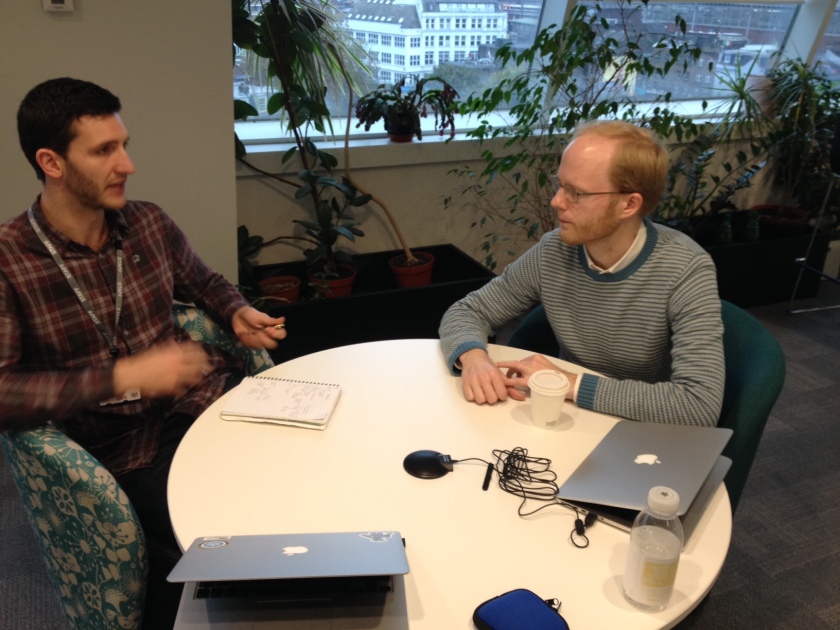I’ve spent the last year or so working with teams in the early stages of Product Discovery – examining the needs of users, and forming ideas and prototypes of services we can deliver to meet those needs.
One thing I’ve seen is the tendency in those teams to have the same conversations about a particular topic or idea several times over. Sometimes in the office, sometimes over lunch, and sometimes in the pub after work (which is where a lot of good ideas form).
This isn’t necessarily a bad thing while we’re shaping our ideas and building consensus in small groups. But once we’ve found ourselves repeating, and agreeing, the same concepts a few times, it feels like it’s time to get things out of our heads and onto some paper, so that we can share the idea further, and build a broader consensus.
The worst case scenario is if we don’t do this, that a small group forms an idea and assumes everyone else is also thinking the same thing. In the early stages of delivering a new service for users, building shared understanding across the whole team is critical.
Audio recording
A nice idea we tried recently was to get a small group of us (three worked nicely) to record the conversation. Kudos to @evilstreak for taking inspiration from the work @mattsheret has done with us on blogging.
We found a quiet space and used a USB mic (that we use for remote meetings) and Quicktime to record our conversation for about 30 minutes.
We didn’t write anything down beforehand, but the conversation was fairly structured, as we’d already had similar versions of it before.

One side-effect of the recording was that we were a bit more conscious of what we were saying, and avoided any unnecessary rambling. Being aware of the recording also stopped us from talking over each other at all. This is something we sometimes suffer from, as everyone has so many ideas to share, people just want to get them out there.
After the recording we transcribed it verbatim into a document. By sharing the audio file, two people were able to work in parallel for 30 minutes to get the whole conversation transcribed.
Pro-tip – using VLC to play back the conversation at a slightly slower speed (about 80%) allowed the typist to keep pace with the conversation without having to pause and replay bits. If you’re a really fast typist maybe you won’t need this.
Listening again to the recording actually helped ideas to crystallise in peoples’ minds. You were listening more intently, rather than thinking about what to say next, as you might in conversation.
Getting feedback from the wider team
As it was just three of us that had the initial conversation, we needed to gather feedback from the wider team.
Initially sharing the transcript was a useful way to share the ideas. Teammates reported that reading the transcript was a very natural way to read, and understand the ideas.
We then began to structure it into a more coherent narrative. Using a tool that enables quick electronic collaboration (like Google Docs) is really handy here. Everyone can be in the same version of the document at the same time – teammates can add comments, responses can be seen instantly, and everyone can see updates as they’re being made.
Crits
We supplement this electronic collaboration with group crit sessions.
Anyone interested in providing feedback gathers around a table and we read through some ideas and have a time-boxed discussion with the goal of gathering specific change to make to the narrative.
In this case we quickly realised that we didn’t have consensus across our team. Lot of new ideas came from these sessions, and the original narrative gave us a way of framing this discussion.
A picture speaks quite a few words
Another (fairly obvious) way of clarifying thoughts and ideas was to do quick sketches of your thoughts. Drawing something and showing it around was a really quick way of prompting further conversation to build shared understanding.

It’s handy to draw something and then pass it to a colleague without explaining what it shows, then ask them to explain their understanding of it.
Building consensus in public
So we’ve built some consensus amongst ourselves, within our team. Next we need to build some consensus with the wider world outside of our team – with our stakeholders and with the public.
We need to be open with our ideas as early as possible for a couple of reasons –
- All the services we’re delivering are created for, and paid for by, the public. We should be transparent about how we’re spending public money.
- The health and care system is complex. There are many different organisations involved. Being open about our ideas and proposals early on is a good way of getting the message out to these organisations, and starting a conversation with them.
One way in which we share our ideas openly is by blogging.
The document and drawing described above were drafted into an initial blog post by @evilstreak and @paul_furley, the drawing was redrawn by @demotive, and the resulting post is here – Booking is critical for transforming healthcare


